Opinion
What the NFT World Can Learn From the Great ’90s Comic Book Bubble. (It’s a Cautionary Tale)
Lessons for Beeple and Grimes from the days of Deadpool and Spawn.
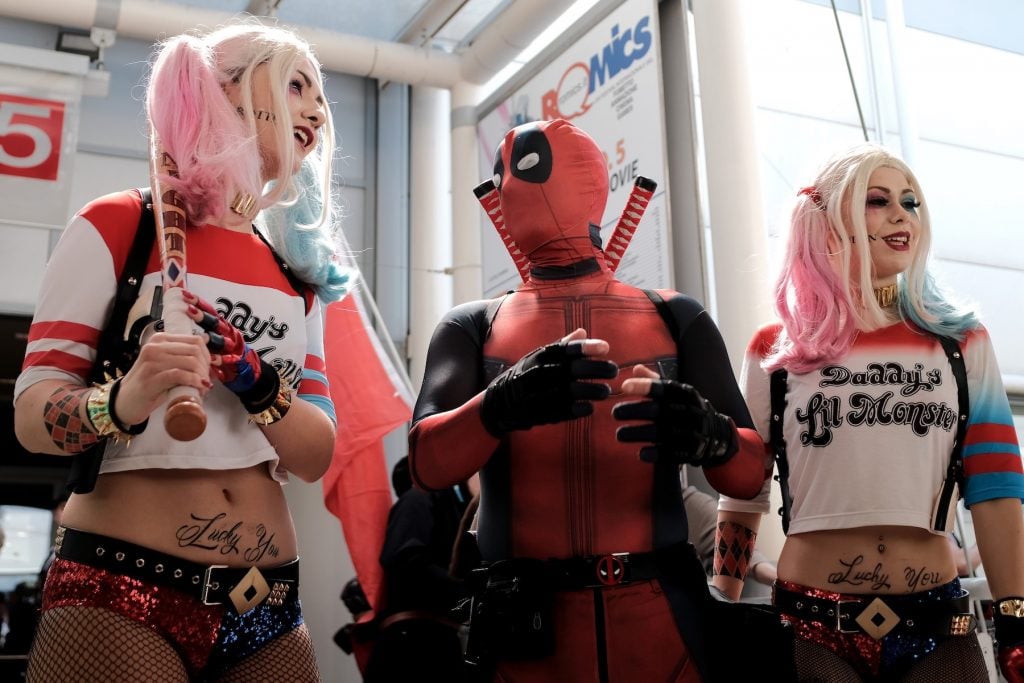
Lessons for Beeple and Grimes from the days of Deadpool and Spawn.

Ben Davis

I was giving a lecture to an undergraduate class at NYU a few weeks ago. NFTs were not the subject, but in the Q&A period one student asked me what I thought about NFTs.
I told him I was watching the space, but hadn’t much to say yet, and asked what he thought. He said NFTs were the future, that in a generation they would be the only art that matters, and he kept reeling off prices: this CryptoPunk went for this amount, such and such sold for so much on Nifty Gateway, etc.
I kept trying to bring the conversation back around: “Yes, but what do you like about these images as art?” He kept coming back at me with the prices.
Finally, after I raised the art question one last time, he said in exasperation: “Ben, when the Maurizio Cattelan banana sold at Art Basel—what was the headline? The money! The money is the art.” (I’m paraphrasing, of course, but it’s close.)

Fairgoers take pictures of Maurizio Cattelan’s Comedian, for sale from Perrotin at Art Basel Miami Beach. Photo by Sarah Cascone.
“People are paying [insert outrageous price] for [insert unbelievable thing]?!?” is one of two or three archetypal art stories, as far as the popular interest is concerned. In that sense, NFTs may be new and baffling to the art world, even as they are a kind of an enticingly rarified version of its most ancient commercial mythology.
And look, before I go any further, I want to make something clear: I am very much pro digital art. I am pro digital art, and I am pro digital artists making money. I even, once upon a time, judged an art contest in a virtual world!
But there isn’t really a doubt that the current supernova of interest in trading unique digital objects is a bubble. Why do I think that? Well, for one, Mike “Beeple” Winkelmann—the digital artist who essentially became the face of the new speculative frenzy after the $69 million sale of his collage Everydays: The First 5,000 Days at Christie’s earlier this month—himself is convinced it is.
“It is a bubble, to be quite honest,” Beeple told NPR. “I think you are going to see a mad rush of people come to this space. And a lot of the stuff people are making into NFTs is junk, and that stuff won’t hold value.”
Nevertheless, you have to separate the concept of “unique” digital objects that people can buy, as a general idea, from the question of whether or not there is an NFT bubble at this particular moment. There are plenty of artists who are now doing interesting things online, and are very much worth supporting, and NFTs are one way to do it.
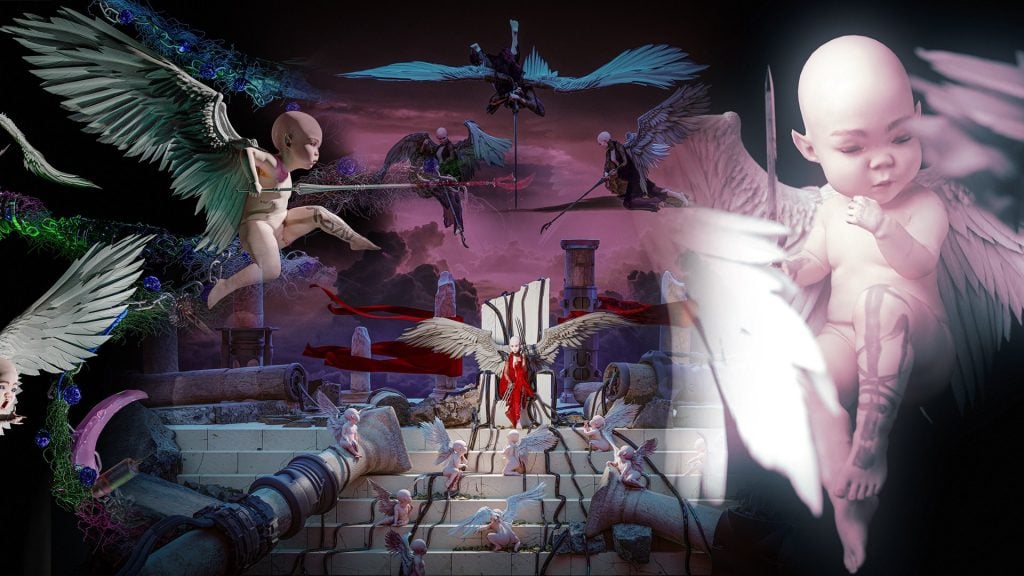
Grimes, Gods in Hi-res. Courtesy of the artist.
Of course, it is a fairly arbitrary way to do it. Musician-turned-artist Grimes sold her “WarNymph Collection Vol. 1” as NFTs and got a huge amount of money. But then again, Grimes also literally sold her soul last year as an artwork, and that required no special blockchain-powered contract. People have been trading “unique” immaterial assets for a long time, and despite the hype, NFTs are just a social convention.
In recent weeks, everyone from old high school buddies to the local news has reached out to ask me what the deal is with NFTs. My colleague Tim Schneider has a great piece about how the current cryptocurrency-fueled froth echoes the epic Impressionist art bubble of the late ’80s, which was fueled by Japanese real estate prices. Given the sheer number of people being drawn into NFTs, the content of the art itself, and the fact that people are making sense of NFTs as “digital trading cards,” I’ve been thinking the most resonant cautionary tale might not be from the fine art world at all.
It might be better to look to the Great Nineties Comic Book Bubble.
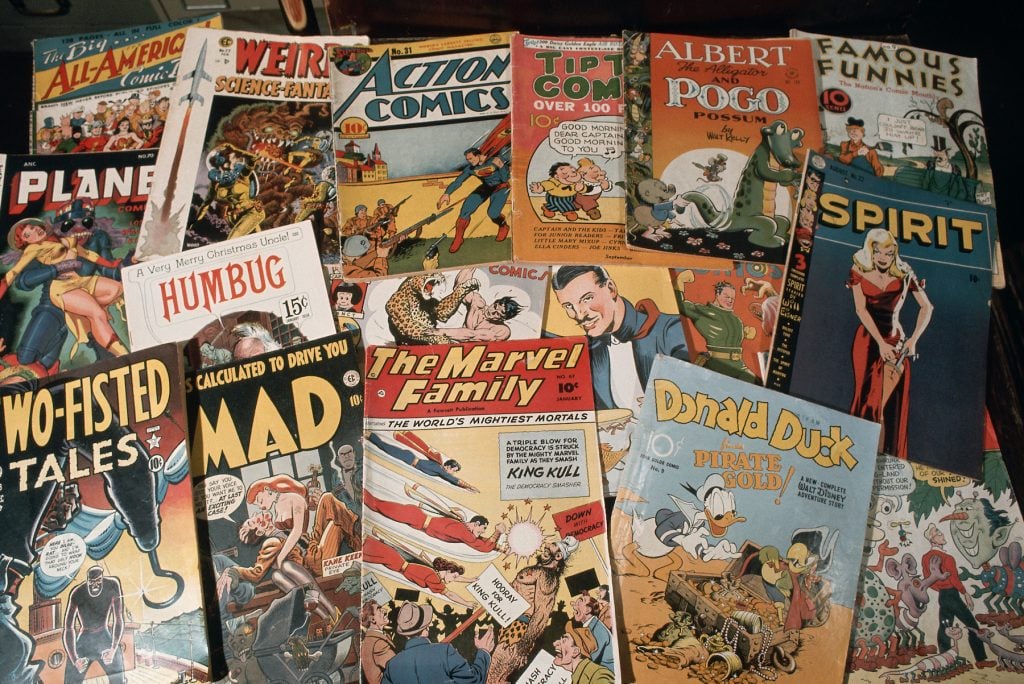
Collection of old comic books. Photo by © Ted Streshinsky/Corbis via Getty Images.
In the 1980s, the bulk of disposable wealth was passing to the Baby Boomers, who had grown up with comic books and had great affection for them, and who were now entering middle age. By 1986, the “grim-and-gritty” turn in comics, signaled by the likes of Frank Miller’s The Dark Knight Returns and Alan Moore’s Watchmen, reflected the interests of this audience, which wanted to be taken seriously and be catered to with storytelling that matched their own adult sensibilities. (I’ve written about this history in more depth for a monograph about the great comics artist Bill Sienkiewicz that came out in 2019 from Six Foot Press.)
Comics were no longer mainly sold to kids in drugstores but to adults in dedicated comic shops. That changed how they were thought of, and valued.
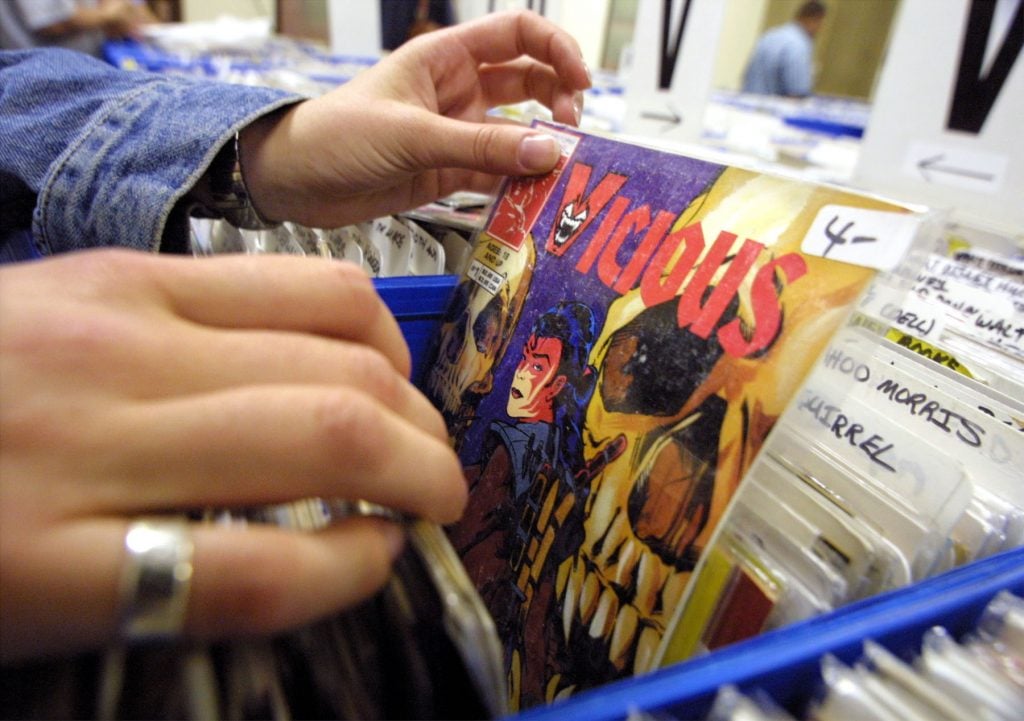
Collectors browse though bins of comic books July 6, 2001 at the Big Apple Comic Book, Art, and Toy Show in New York City. Photo by Mario Tama/Getty Images.
Comic books had once been the very definition of disposable culture. But now prices for early issues featuring popular characters began to rise. Jonathan V. Last explained what happened—and note the role of the auction houses in turbo-charging the phenomenon, much as they are doing for NFTs right now:
In 1974 you could buy an average copy of Action Comics #1—the first appearance of Superman—for about $400. By 1984, that comic cost about $5,000. This was real money, and by the end of the decade, comics sales at auction houses such as Christie’s or Sotheby’s were so impressive that the New York Times would take note when, for instance, Detective Comics #27—the first appearance of Batman—sold for a record-breaking $55,000 in December 1991. The Times was there again a few months later, when a copy of Action Comics #1 shattered that record, selling for $82,500. Comic books were as hot as a market could be. At the investment level, high-value comics were appreciating at a fantastic rate. At the retail level, comic-book stores were popping up all across the country to meet a burgeoning demand. As a result, even comics of recent vintage saw giant price gains. A comic that sold initially for 60 cents could often fetch a 1,000 percent return on the investment just a few months later.
Suddenly, ordinary comic book readers were transformed, in their own minds, into comic book investors. Guides like Wizard allowed people to track secondary prices for back issues. A side industry sprung up in acid-free bags and backing boards, and everyone thought that they had to buy multiple copies of every new issue of their favorite comic—one to actually read, and at least one to seal away as an investment. (My parents are still storing my unread boxes of X-Men extras.)
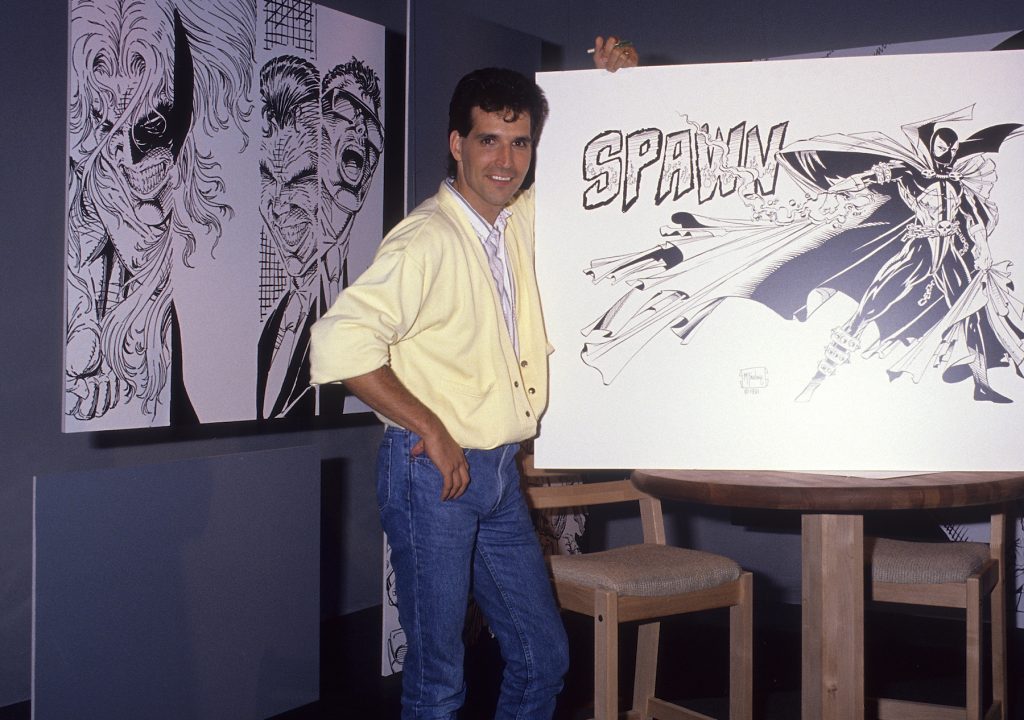
Spawn creator Todd McFarlane attends Comic Book Artists Unite, September 20, 1991 at Valley Production Center in Van Nuys, California. Photo by Ron Galella, Ltd./Ron Galella Collection via Getty Images.
It’s worth mentioning, since the NFT discourse is so much about the respect the market is giving to previously unacknowledged digital artists, that this moment also changed the way comics artists were viewed.
The big comic book companies had notoriously treated their creative talent like dirt, as replaceable cogs in a machine. But with the industry’s new heat, a crop of ’90s artists—Erik Larsen, Rob Liefeld, Jim Lee, Todd McFarlane, Wilce Portacio, Marc Silvestri, and Jim Valentino—suddenly became, in Mike Avila’s words, “the first true comic book rock stars.” (Liefeld was a big enough deal that Spike Lee did a commercial with him for Levi’s.)
These creatives would found their own artist-centered line, Image Comics, in ’92—right in the middle of the speculator storm. It was actually at Sotheby’s first comics art auction in ’91, featuring the original art from Liefeld’s X-Force, Lee’s X-Men, and McFarlane’s Spiderman, that McFarlane made Jim Lee the offer to leave Marvel and join on as a founder at Image. (As for the auction, Lee’s hot-off-the-presses X-Men art sold for $44,000—not that far off the $55,000 paid for Detective Comics #27 from 1939.)
But here was the thing about comic books: like digital art today, the material was defined by its popular audience, and therefore its lack of rarity. Pristine copies of Action Comics #1 or Detective Comics #27 actually were reasonably rare—because no one thought they’d be valuable back in the Depression-era days of their first printing. Most copies had ended up in the garbage.
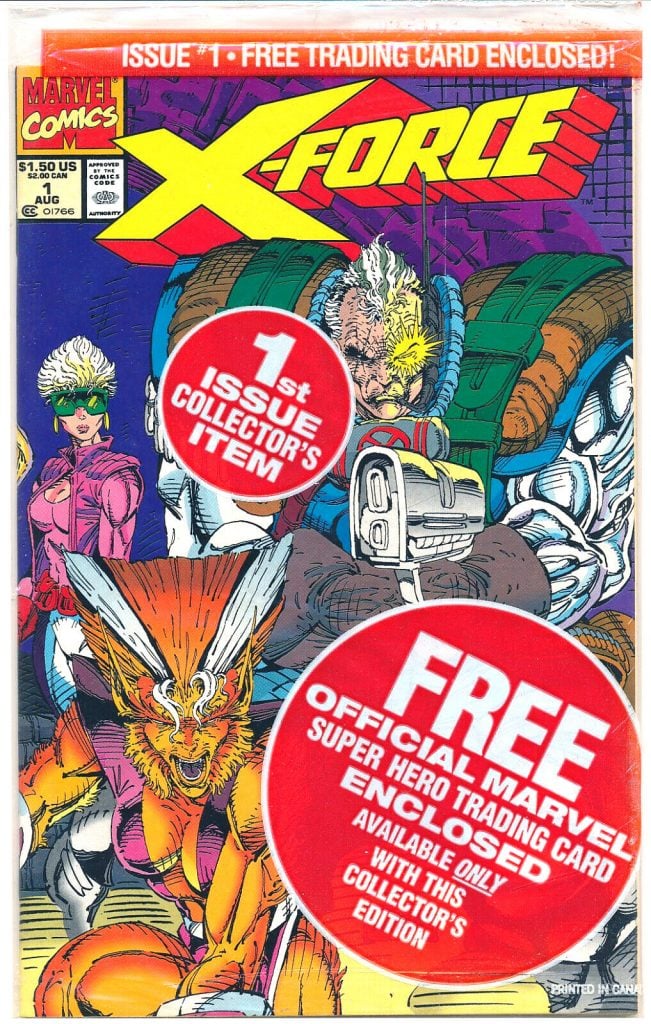
A bagged copy of X-Force #1.
In the ’90s, on the other hand, in order to capitalize on the speculator mania in comics, the big comic companies had to find technical ways to engineer scarcity, to give brand-new objects produced in the hundreds of thousands (or millions) of copies the semblance of rarity. What followed was a maniacal explosion of gimmicks, supplementing the main issues with novelty “variant covers” that were foil, die-cut, glow-in-the-dark, and so on, all with inflated prices.
“Books were literally judged by their covers,” one writer remembered,
Because first issues and first appearances of characters were historically valuable, the publishers then engineered the launch of whole new comics lines so that they could hype a new #1. X-Men #1, spinning off from the long-running Uncanny X-Men in 1991, remains the biggest selling comic book title of all time, coming with multiple covers.
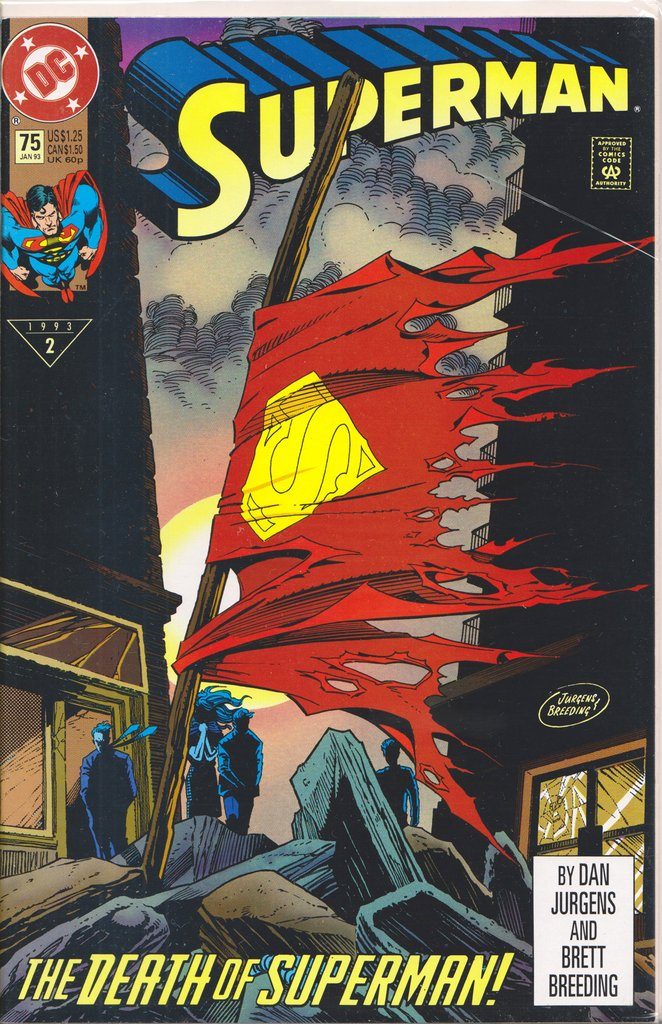
The cover of Superman 75.
All this frenzy led to still-infamous editorial decisions in the attempt to create publishing events that could be credibly sold as historic—most notoriously DC’s 1992 “Death of Superman” storyline that involved the Man of Steel being laid low by a bloated nothing of a baddie named Doomsday.
The event was so heavily promoted that it became a mainstream news story, partly because of Superman’s American icon status, partly because speculator mania had everyone assuming that this landmark comic was a must-own. As Chuck Rozanski, the owner of Mile High Comics, explained in his rueful account of the era:
[T]he comics market going into the early 1990’s had already been severely inflated by the addition of thousands of undercapitalized and unknowledgeable new retailers. It seemed at the time that there was now a comics shop on every corner, and the prevailing illusion was that the owners of these comics shops were all making a great deal of money. As a result, it became a common delusion for a while that you could make a fortune investing in comics. Greed, more than any other factor, is what inspired so many consumers from outside of the traditional comics world to chase after Superman #75. Heck, at least in the first printing, they couldn’t even read the book without reducing it’s “value,” as DC polybagged the issue….
Of course, this was all a smoke-and-mirrors marketing stunt, like many of the other ‘90s comics “firsts.” DC had no intention of actually killing off Superman, who soon returned with a mullet.
Comics were everywhere in the early ’90s. News stories and TV covered the big prices for collectable comics, the insurgent moves of the Image Comics rebels, and the huge lines of normies mobbing comic stores for X-Men #1 or Superman #75.
Jason Sacks, the author of the American Comic Book Chronicles, explains what happened next. The hype led to a “gold rush of people looking to pay their kids’ college funds with profits from holographic issues of Fantastic Four, The Death of Superman, Turok: Dinosaur Hunter, and Youngblood.” But this was built on sand. “When they found their copy of Bloodshot No. 1 was worthless because everyone owned that comic, that helped spark the bust in sales that crushed the industry for the rest of the decade.”
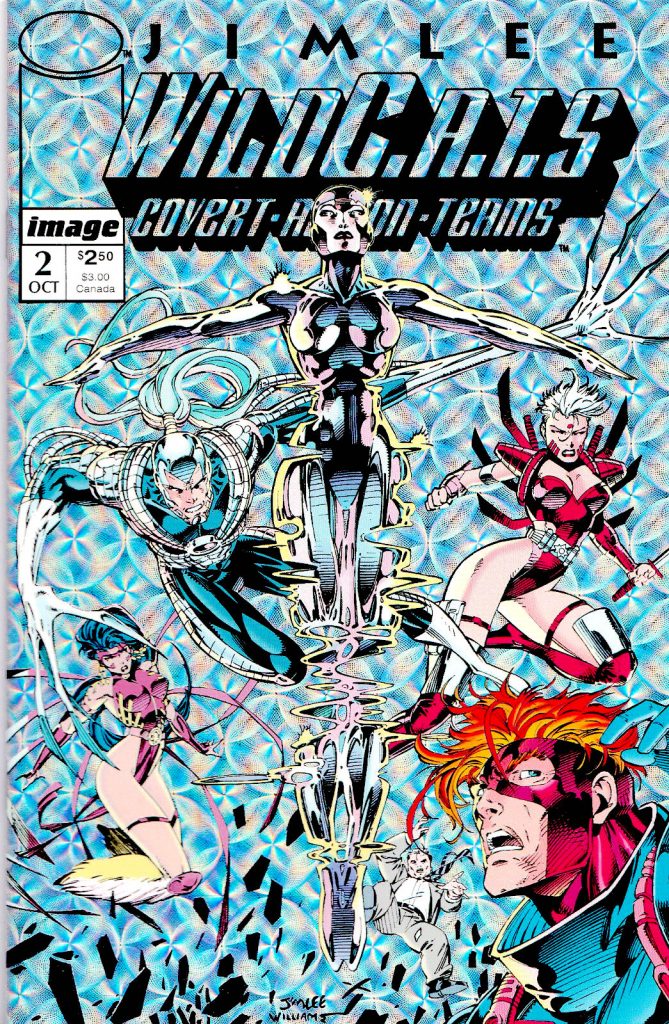
Wild C.A.T.S. 2, with special “prism foil” cover variant.
The result is that a lot of teenagers were fleeced of money, which is lousy, but not tragic. But the market mania also degraded the quality of the comics via stupid stunts and endless crossovers in an attempt to keep sales inflated, turning off a generation of fans. Amid the media frenzy and adulation, the Image Comics creators largely forgot to take care of small details like keeping deadlines, creating fresh characters, or telling interesting stories, squandering their moment.
The words “The Nineties” still conjure images, in comic circles, of embarrassing excess: sprawling, fan-alienating crossovers and events; steroidal, interchangeably grizzled male heroes with lots of pointless pockets; wasp-waisted female heroes with pneumatic breasts; and clueless speculators hoarding black-bagged issues of Superman #75.
Thousands of store owners who had taken out loans and invested hopes and money in the industry’s future lost their shirts, drowning in unsold inventory; nine out of ten comics stores collapsed by ’96. Marvel Comics, the biggest, most popular player, ended up filing for bankruptcy amid the fallout.
“When the business turned,” Marvel CEO Scott Sassa lamented, “it was like everything that could go wrong did go wrong.”
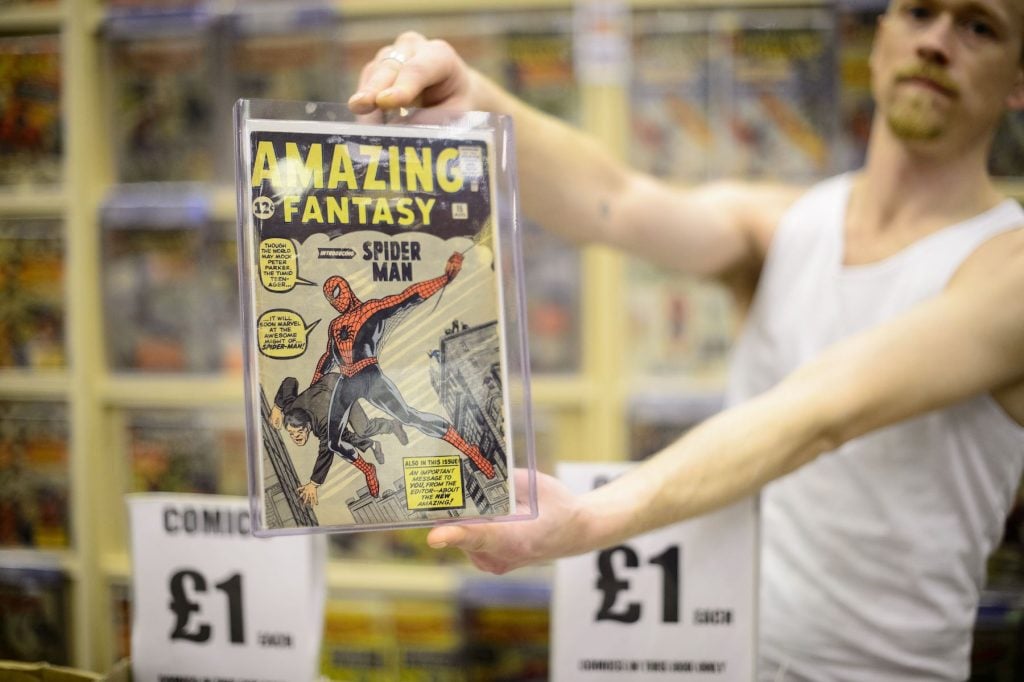
A stall-holder holds up a copy of the first comic book to feature Spiderman at the London Film and Comic Con 2014 in Earls Court. Photo be Leon Neal/AFP via Getty Images.
The NFT boom is different—every bubble is different in some way, “this time it’s different” being the requisite promise to get people hooked. Among other things, it is much, much bigger and has appeared much, much faster.
If the comic boom was fed by monied Baby Boomers staking their claim as tastemakers, the digital art boom relates to the rise of digital natives with an affection for meme-y stuff and different ideas of ownership. (E.g., you don’t “own” any of the music or videos you watch anymore as objects; plenty of people have bought virtual skins and weapons in video games to accrue status.)
But it’s also fed by desperation—of investors looking for returns and of ordinary people looking for any credible idea of economic deliverance amid stagnant prospects. Reading about the ’90s Comics Bubble, you hear a lot about people buying boxes of comics as investments, quixotically dreaming that they will help to pay for their kids’ college or fund their retirement. In the 30 years since, higher education has grown astoundingly more expensive while retirement has moved further and further out of reach.
There are plenty of people who think that the world economy as a whole is in a massive asset price bubble right now. Nikkei Asia cites evidence of bubbles everywhere, from record sales of toy cars to the price of cow gallstones in China. I mean, shoot, it was only a month ago—before NFTs became the chatter, if you believe it—that people were having their minds blown by the money being made by people flipping old-fashioned trading cards, with one trader telling CNN that “there’s never been a time like this.”
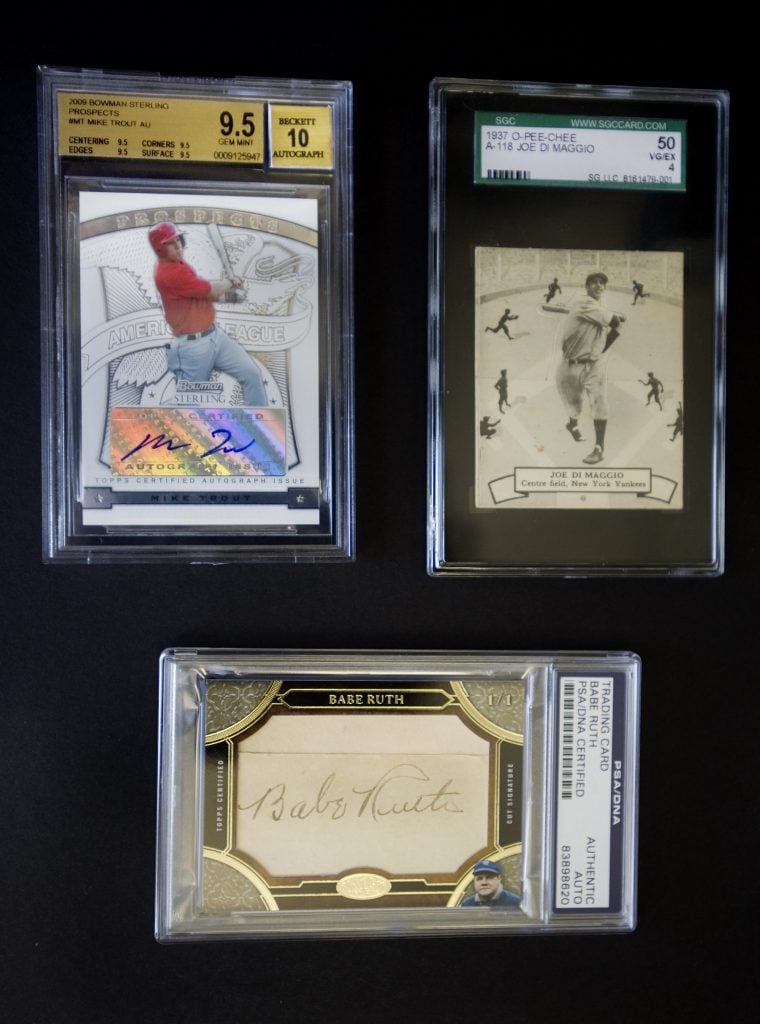
Rare collectable baseball cards at Taylor’s Baseball Cards and Collectables. From top left: Mike Trout, Joe DiMaggio, and Babe Ruth. Photo by The Orange County Register/MediaNews Group via Getty Images.
With interest at rates close to zero, money has poured into speculative assets, including cryptocurrency. NFTs have appeared as the latest and most successful attempt to get the general public interested in Ethereum, making the case for it as more than just an environmentally cataclysmic novelty. The high prices bid at auction for digital art are doubling as advertising for the Ethereum holdings of these huge investors, looking to stop popular backlash and to find a pool of greater fools to take it off their hands.
Look, here’s a secret about artworks, and about collectibles in general: the ones that are investments are rare, by definition. Just because you can buy digital art now, and that NFTs are technically “unique,” doesn’t make them meaningfully unique or destined, on average, to appreciate in any way in the long or even medium term. Most experts will tell you not to buy art for profit, but for passion, because it’s almost impossible to predict what society will value in 5 years, let alone 30 or 50. That’s why it’s dangerous that the NFT boom has people thinking the “money is the art.”
Mostly, value reverts to nothing, as anyone who has tried to price old paintings from an estate or unload boxes of used comic books knows.
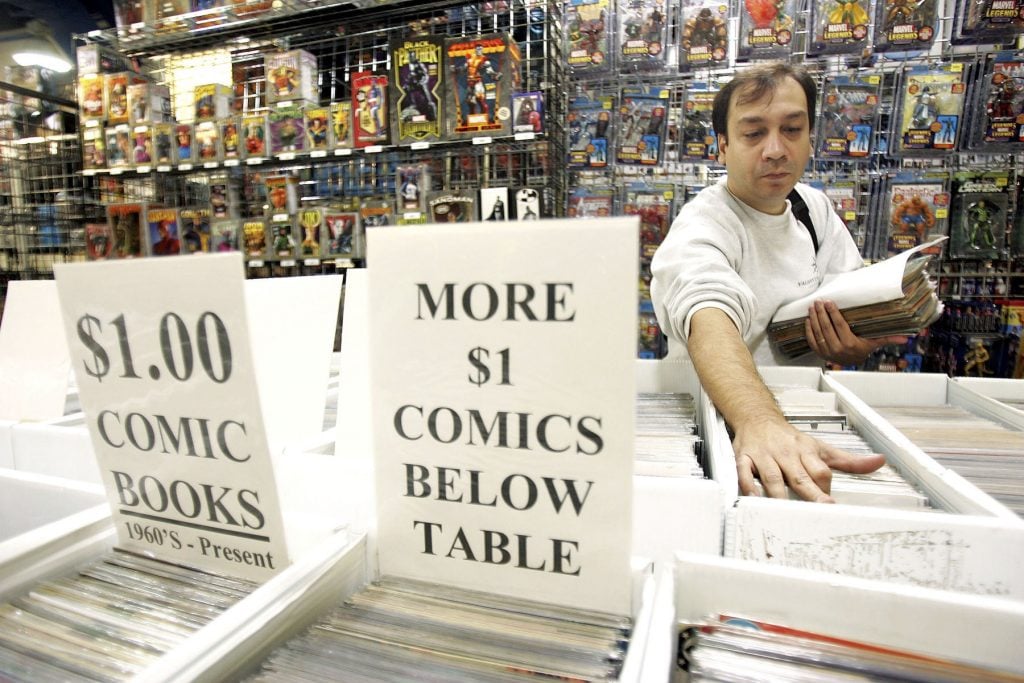
A comic book collector browses comics at the 10th Annual Big Apple National Comic Book, Toy & Sci-Fi Expo at Penn Plaza Pavillion November 18, 2005 in New York City. Photo by Scott Gries/Getty Images.
If someone is trying to tell you that some kind of new class of collectable somehow violates that law, they are trying to trick you, or they are deluded.
It is not a knock on digital art or digital artists to be skeptical of the NFT hype. If you care about and are interested in digital art and digital artists then you should be skeptical of the NFT hype. The relevant history shows that it will warp values towards stunts and flavor-of-the-millisecond material. The signs all point one way: towards a date with Doomsday.